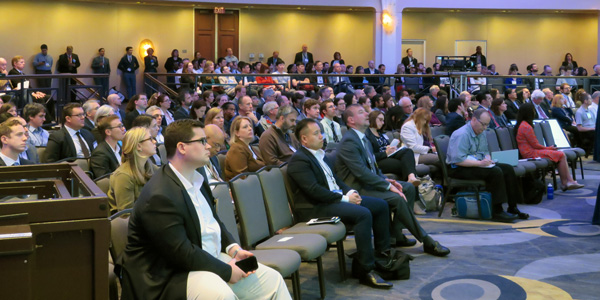WASHINGTON — The headlines at the Energy Information Administration’s 2018 Energy Conference were generated backstage, as FERC Chairman Kevin McIntyre and Department of Energy Undersecretary Mark Menezes were questioned by reporters about President Trump’s coal and nuclear bailout after their speeches. (See FERC Blindsided by Half-Baked Trump Order.)
But an earlier panel featuring officials from PJM, ERCOT and GE Power also provided some highlights. Stan Kaplan, director of EIA’s Office of Electricity, Renewables and Uranium Statistics, moderated questions from the audience.
Are microgrids a fad?
No, said Eric Gebhardt, chief innovation officer for GE Power.
“In many cases, the microgrids are being installed [for industrial uses] because of higher-cost electricity. … A 10-MW natural gas [reciprocating generator] can produce a [levelized cost of energy] of around 6 cents/kWh, which is extremely competitive.”
Adding cogeneration, “a [combined heat and power] application where you take the heat off that to create steam for your process or you use it for HVAC purposes, it drives the value even further. … With a combined heat and power [application], you could be pushing 90% efficiency in the overall cycle, which is great efficiency.
“The second thing is many customers are looking to decarbonize by putting in solar in conjunction with this. And then you start using energy storage as part of that for peak demand clipping, because many times these microgrids don’t [supply] 100% of the load. They might be 80% of the load, might be 70% of the load … so, there’s many ways it can be economic.”
In contrast, he said, microgrids “trying to be completely off-grid … that’s not always an economic way to operate today, or not necessarily the most economic way to operate today.”
Does a more intelligent, distributed grid increase resilience or make us more vulnerable to cyberattacks?
“Arguably, spreading things out, having distributed resources, microgrids, are in one way maybe increasing the cyber grid [attack surface],” said Craig Glazer, vice president of federal government policy for PJM. “You’re also enabling [resilience]. It’s not like you can attack one substation and take out metropolitan areas. So, I think on balance [there’s] probably more benefit to that.”
The bigger challenge, Glazer said, is that there are no mandatory cybersecurity standards for the natural gas pipeline industry, unlike the electric grid.
“You know who regulates the cybersecurity of the natural gas pipeline industry? The TSA [Transportation Security Administration], the people that check your bags at the airport. …
“There is a very small staff. They’re dedicated people. But it’s a very small staff totally underwater, frankly, in this area.
“If you hit the fuel supply, you’re going to have an impact on the electric grid, yet we somehow have just accepted a vastly different structure: voluntary, suggested standards for the pipelines versus mandatory standards for the electric grid.”
Are the industry’s capabilities keeping pace with the increasingly intelligent, complex grid and the growth of behind-the-meter generation?
“It’s a great question that I don’t know the answer to,” said Beth Garza, director of the ERCOT Independent Market Monitor.
“The interaction of more and more data [with] finer granularity, and then having the systems and tools to process this … to turn it into actionable information, I think is a challenge. I tend to be optimistic on all of that … but I do see it as a challenge.”
Gebhardt agreed. “How do you deal with going from a thousand centralized power plants to hundreds of thousands and hundreds of millions of end nodes that are going to be producing power, as well as being able to curtail power, simultaneously? How does all of that get managed? That’s going to be something that many utilities and technology companies have to deal with.”
Glazer recalled the April 2015 power outage that darkened the White House and much of downtown D.C. NERC said it began with the failure of a 230-kV lightning arrester 40 miles south of the capital. (See Failed Lightning Arrester Caused April Outage.)
“The outage was not that big a deal, but the restoration was much more complicated because [PJM], as well as the local utility [Pepco], didn’t have any visibility into which buildings had backup generation and were running them and which ones didn’t.
“So, the [National] Air and Space Museum had backup generation; the Hirshhorn Museum didn’t. But nobody knew that. This happened on a patchwork all through Washington. It made the restoration that much more difficult.”
California’s solar generation has produced the late afternoon duck curve. Why don’t we hear about ramping challenges in ERCOT?
“Part of the challenge in California is that customers don’t use as much electricity as they do in Texas,” Garza said. “It is very much driven by [Texas’] air conditioning load in the summertime. That is supported by solar [generation] but any kind of projection I’ve done that’s grossed up the solar curve on our load curve, I can’t get Texas to look like the California duck curve.”
Will energy storage replace combustion turbine peaking plants?
“That question comes up a lot,” Gebhardt said. “I look at it more as an ‘and’ versus an ‘or’ question, because there’s so many existing peaking plants that are out there right now. Combining them in a hybrid application with energy storage brings tremendous value. … The batteries handle the really fast ramp rates and allow the gas turbine to come on at a slower ramp rate going from a dead stop. … And if you have it there, it also serves other purposes — voltage support, frequency response…
“Certain parts of the U.S. are testing markets, saying we would take either a combined cycle gas turbine or some sort of gas turbine or energy storage. … But for the vast majority, the ‘and’ solution is probably the better one.”








